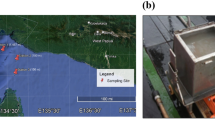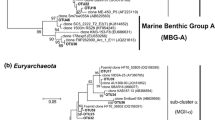Abstract
16S rRNA gene-based molecular analyses revealed the presence of several large and so far uncultivated clades within class γ-Proteobacteria, designated γ-proteobacterial marine sediment (GMS) clades 1 to 4, in marine sediment. The GMS clades appear only indigenous to marine sediment and so far have an unknown functionality. SYBR Green–based real-time PCR analyses using GMS clade-specific primers indicated GMS clades were a significant part of the bacterial community (0.3–8.7% of total 16S rRNA genes) in both polar and temperate marine sediment samples. Univariate statistical analyses indicated that GMS clade communities were indistinguishable in two temperate coastal sediment samples even though these possessed very different mean grain sizes, organic contents, and organic loading rates. GMS clade communities were slightly different (p < 0.05) between polar and temperate sites, suggesting that psychrophilic adaptation among GMS clade taxa corresponds only to subtle phylogenetic differences. Similar levels of difference were also observed through a sediment core reflecting that through the sediment core history, which spanned ∼3000 years, GMS clonal diversity shifted only marginally.




Similar content being viewed by others
References
JP Anderson GH Learn AG Rodrigo X He Y Wang H Weinstock ML Kalish KE Robbins L Hood JI Mullins (2003) ArticleTitlePredicting demographic group structures based on DNA sequence data Mol Biol Evol 20 1168–1180
Anderson MJ (2003) CAP: A FORTRAN computer program for canonical analysis of principle coordinates. Department of Statistics, University of Auckland, Auckland, New Zealand
JP Bowman SM Rea SA McCammon TA McMeekin (2000) ArticleTitleDiversity and community structure within anoxic sediment from marine salinity meromictic lakes and a coastal meromictic marine basin, Vestfold Hills, Eastern Antarctica Environ Microbiol 2 227–237
JP Bowman SA McCammon JAE Gibson PD Nichols L Robertson (2003) ArticleTitleMicrobial metabolic activity and community structure within Antarctic continental shelf sediment Appl Environ Microbiol 69 2448–2462
JP Bowman RM McCuaig (2003) ArticleTitleDiversity and biogeography of prokaryotes dwelling in Antarctic continental shelf sediment Appl Environ Microbiol 69 2463–2484
BJ Campbell C Jeanthon JE Kostka GW Luther SC Cary (2001) ArticleTitleGrowth and phylogenetic properties of novel bacteria belonging to the epsilon subdivision of the Proteobacteria enriched from Alvinella pompejana and deep-sea hydrothermal vents Appl Environ Microbiol 67 4566–4572
MG Chapman AJ Underwood (1999) ArticleTitleEcological patterns in multivariate assemblages: information and interpretation of negative values in ANOSIM tests Mar Ecol Prog Ser 180 257–265
A Cifuentes J Anton S Benlloch A Donnelly RA Herbert F Rodriguez-Valera (2000) ArticleTitleProkaryotic diversity in Zostera noltii-colonized marine sediments Appl Environ Microbiol 66 1715–1719
KR Clarke M Ainsworth (1993) ArticleTitleA method of linking multivariate community structure to environmental variables Mar Ecol Prog Ser 46 213–226
KR Clarke RM Warwick (2001) Change in Marine Communities: An Approach to Statistical Analysis and Interpretation EditionNumber2 Primer-E Ltd. Plymouth, UK
CM Crawford IM Mitchell CKA MacLeod (2001) ArticleTitleVideo assessments of environmental impacts of salmon farms ICES J Mar Sci 58 445–452
Dann, AL (2003) Honours thesis. School of Agricultural Science, University of Tasmania, Australia
PR Ehrlich AH Ehrlich (1981) Extinction. The Causes and Consequences of the Disappearance of Species Random House New York
Felsenstein, J (1993) PHYLIP, phylogenetic inference package. http://evolution.genetics.washington.edu/phylip.html
TA Hall (1999) ArticleTitleA user-friendly biological sequence alignment editor for Windows 95/98/NT Nucleic Acids Symp Ser 41 95–98
PT Harris G Brancolini L Armand M Busetti RJ Beaman G Giorgetti M Presti F Trincardi (2001) ArticleTitleContinental shelf drift deposit indicates non-steady state Antarctic bottom water production in the Holocene Mar Geol 179 1–8
F Inagaki Y Sakihama A Inoue C Kato K Horikoshi (2002) ArticleTitleMolecular phylogenetic analyses of reverse-transcribed bacterial rRNA obtained from deep-sea cold seep sediments Environ Microbiol 4 277–286
PK Kemp JY Aller (2004) ArticleTitleBacterial diversity in aquatic and other environments: what 16S rDNA libraries can tell us FEMS Microbiol Ecol 47 161–177
NC Kenkel L Orloci (1986) ArticleTitleApplying metric and nonmetric multidimensional scaling to some ecological studies: some new results Ecology 67 919–928
JB Kruskal (1964) ArticleTitleMultidimensional scaling by optimizing goodness of fit to a nonmetric hypothesis Psychometrika 29 1–27
DJ Lane (1991) 16S/23S rRNA sequencing E Stackebrandt M Goodfellow (Eds) Nucleic Acid Techniques in Bacterial Systematics John Wiley & Sons New York 115–175
P Legendre MJ Anderson (1999) ArticleTitleDistance-based redundancy analysis: testing multispecies responses in multifactorial ecological experiments Ecol Monogr 69 1–24
L Li C Kato K Horikoshi (1999) ArticleTitleBacterial diversity in deep-sea sediments from different depths Biodivers Conserv 8 659–677
L Li C Kato K Horikoshi (1999) ArticleTitleMicrobial diversity in sediments collected from the deepest cold-seep area, the Japan Trench Mar Biotechnol 1 391–400
P Lopez-Garcia S Duperron P Philippot J Foriel J Susini D Moreira (2003) ArticleTitleBacterial diversity in hydrothermal sediment and epsilon proteobacterial dominance in experimental microcolonizers at the Mid-Atlantic Ridge Environ Microbiol 5 961–976
Macleod, C, Bissett, A, Burke, C, Connell, R, Holdsworth, D, Forbes, S, Nichols, P, Revill, A, Volkman, J (2004) Development of novel methods for the assessment of sediment condition and determination of management protocols for sustainable finfish cage aquaculture operations. FRDC Report 2000/164; Aquafin CRC Report 4.1
VM Madrid JY Alter RC Aller AY Chistoserdov (2001) ArticleTitleHigh prokaryote diversity and analysis of community structure in mobile mud deposits off French Guiana: identification of two new bacterial candidate divisions FEMS Microbiol Ecol 37 197–209
J O’Mahony C Hill (2002) ArticleTitleA real time PCR assay for the detection and quantitation of Mycobacterium avium subsp. paratuberculosis using SYBR Green and the Light Cycler J Microbiol Methods 51 283–293
SM Powell JP Bowman I Snape JS Stark (2003) ArticleTitleMicrobial community variation in pristine and polluted nearshore Antarctic sediments FEMS Microbiol Ecol 45 135–145
KJ Purdy TM Embley S Takii DB Nedwell (1996) ArticleTitleRapid extraction of DNA and rRNA from sediments by a novel hydroxyapatite spin-column method Appl Environ Microbiol 62 3905–3907
MS Rappé PF Kemp SJ Giovannoni (1997) ArticleTitlePhylogenetic diversity of marine coastal picoplankton 16S rRNA genes cloned from the continental shelf off Cape Hatteras, N.C Limnol Oceanogr 42 811–826
K Ravenschlag K Sahm J Pernthaler R Amann (1999) ArticleTitleHigh bacterial diversity in permanently cold marine sediments Appl Environ Microbiol 65 3982–3989
K Ravenschlag K Sahm C Knoblauch BB Jørgensen R Amann (2000) ArticleTitleCommunity structure, cellular rRNA content, and activity of sulphate-reducing bacteria in marine Arctic sediments Appl Environ Microbiol 66 3592–3602
K Ravenschlag K Sahm R Amann (2001) ArticleTitleQuantitative molecular analysis of the microbial community in marine Arctic sediments (Svalbard) Appl Environ Microbiol 67 387–395
F Ronquist JP Huelsenbeck (2003) ArticleTitleMrBayes 3: Bayesian phylogenetic inference under mixed models Bionformatics 19 1572–1574
JS Stark MJ Riddle I Snape RC Scouller (2003) ArticleTitleHuman impacts in Antarctic marine soft-sediment assemblages: correlations between multivariate biological patterns and environmental variables Estuarine Coastal Shelf Sci 56 717–734
K Takai F Inagaki S Nakagawa H Hirayama T Nunoura Y Sako KH Nealson K Horikoshi (2003) ArticleTitleIsolation and phylogenetic diversity of members of previously uncultivated ε-Proteobacteria in deep-sea hydrothermal fields FEMS Microbiol Lett 218 167–174
A Teske KU Hinrichs V Edgcomb A Vera Gomez Particlede D Kysela SP Sylva ML Sogin HW Jannasch (2002) ArticleTitleMicrobial diversity of hydrothermal sediments in the Guaymas Basin: evidence for anaerobic methanotrophic communities Appl Environ Microbiol 68 1994–2007
Acknowledgments
Support for this study came from University of Tasmania IRGS funding (grant no. B0013108) and from the Australian Research Council funds (grant no. F09905711). We thank Andrew Bissett for the Tasmanian sediment DNA samples and Catriona MacLeod for access to the Primer 5 program.
Author information
Authors and Affiliations
Corresponding author
Rights and permissions
About this article
Cite this article
Bowman, J., McCammon, S. & Dann, A. Biogeographic and Quantitative Analyses of Abundant Uncultivated γ-Proteobacterial Clades from Marine Sediment. Microb Ecol 49, 451–460 (2005). https://doi.org/10.1007/s00248-004-0070-2
Received:
Accepted:
Published:
Issue Date:
DOI: https://doi.org/10.1007/s00248-004-0070-2




